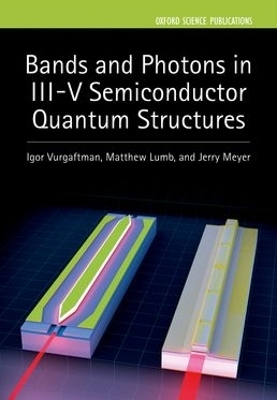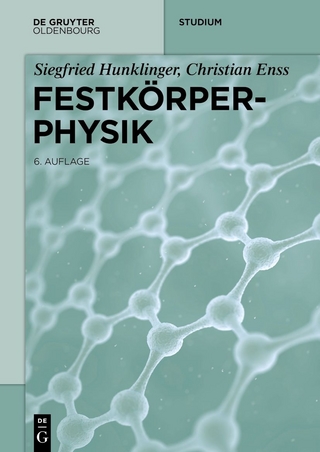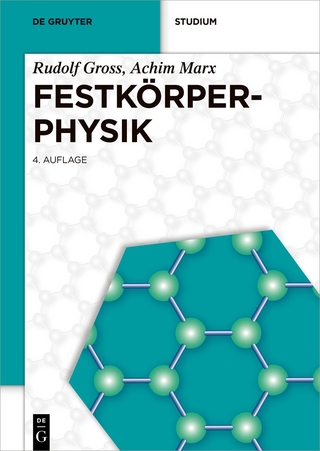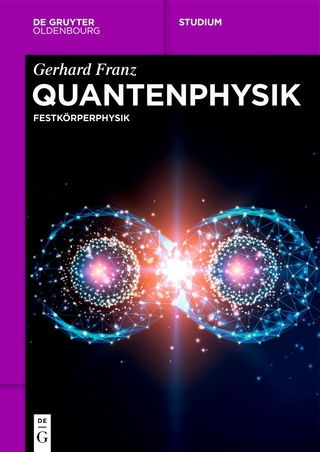
Bands and Photons in III-V Semiconductor Quantum Structures
Oxford University Press (Verlag)
978-0-19-876727-5 (ISBN)
Semiconductor quantum structures are at the core of many photonic devices such as lasers, photodetectors, solar cells etc. To appreciate why they are such a good fit to these devices, we must understand the basic features of their band structure and how they interact with incident light. Many books have taken on this task in the past, but their treatments tend either to pluck results from the literature and present them as received truths or to rely on unrealistically simple models.
Bands and Photons in III-V Semiconductor Quantum Structures takes the reader from the very basics of III-V semiconductors (some preparation in quantum mechanics and electromagnetism is helpful) and shows how seemingly obscure results such as detailed forms of the Hamiltonian, optical transition strengths, and recombination mechanisms follow. The reader would not need to consult other references to fully understand the material, although a few handpicked sources are listed for those who would like to deepen their knowledge further. Connections to the properties of novel materials such as graphene and transition metal dichalcogenides are pointed out, to help prepare the reader for contributing at the forefront of research in those fields.
The book also supplies a complete, up-to-date database of the band parameters that enter into the calculations, along with tables of optical constants and interpolation schemes for alloys. From these foundations, the book goes on to derive the characteristics of photonic semiconductor devices (with a focus on the mid-infrared) using the same principles of building all concepts from the ground up, explaining all derivations in detail, giving quantitative examples, and laying out dimensional arguments whenever they can help the reader's understanding.
Dr. Igor Vurgaftman received the Ph. D. degree in electrical engineering from the University of Michigan. Since 1995 he has been with the Optical Sciences Division of the Naval Research Laboratory (NRL), where he is currently Head of the Quantum Optoelectronics Section. He is the author of more than 280 refereed articles in technical journals, cited more than 14,000 times (h-index of 46) as well as more than 20 patents. Dr. Vurgaftman is a Fellow of the American Physical Society and the Optical Society. Dr. Matthew Lumb received a Ph.D in Physics from Imperial College London in 2009. He was then appointed as lead device modeler for QuantaSol Ltd., manufacturing state of the art, multi-junction solar cells using strain-balanced quantum wells. In 2011, Dr. Lumb joined The George Washington University, based full time at the Naval Research Laboratory, in Washington DC, researching numerous aspects of optoelectronic devices, including high efficiency, multi-junction solar cells. He is currently principal investigator on an ARPA-E MOSAIC award, developing novel concentrator photovoltaic (CPV) arrays using micro-CPV cells. He has authored and co-authored over 120 journal articles and conference papers and holds 2 patents. Dr. Jerry Meyer received the Ph.D. in Physics from Brown University in 1977. Since then he has carried out basic and applied research at the U.S. Naval Research Laboratory, where he is Navy Senior Scientist for Quantum Electronics. His research has focused on semiconductor optoelectronic materials and devices, especially new classes of semiconductor lasers and detectors for the infrared. He is a recipient of the Presidential Rank Award (2016), ONR's Captain Robert Dexter Conrad Award for Scientific Achievement (2015), NRL's E. O. Hulbert Annual Science Award (2012), the IEEE Photonics Society Engineering Achievement Award (2012), the Dr. Dolores M. Etter Top Navy Scientists and Engineers of the Year Award (2008), and the NRL Edison Chapter Sigma Xi Award for Pure Science (2003). He has co-authored 390 refereed journal articles that have been cited more than 24,000 times (H-Index of 63), 37 patents, and 180 Invited, Plenary, Keynote, and Tutorial conference presentations.
1: Basics of Crystal Structure and Band Structure
2: Introduction to k×p Theory
3: Detailed k-p Theory for Bulk III-V Semiconductors
4: Absorption and Emission of Light in III-V semiconductors
5: Other Techniques for Calculating Semiconductor Band Structure
6: Binary Compound Semiconductors
7: Alloys and Exotic Materials
8: Basics of Envelope-Function Theory
9: Methods for Computing the States of Quantum Structures
10: Superlattice and Quantum-Well Band Structure
11: Absorption and Emission of Light in Quantum Structures
12: Semiconductor Photonic Devices
13: Quantum Cascade Lasers
14: Semiconductor Photodetectors
15: Solar Cells, Thermophotovoltaics, and Nonlinear Devices
| Erscheinungsdatum | 05.02.2021 |
|---|---|
| Reihe/Serie | Series on Semiconductor Science and Technology ; 25 |
| Zusatzinfo | 358 line drawings and halftones |
| Verlagsort | Oxford |
| Sprache | englisch |
| Maße | 177 x 254 mm |
| Gewicht | 1430 g |
| Themenwelt | Naturwissenschaften ► Physik / Astronomie ► Festkörperphysik |
| Naturwissenschaften ► Physik / Astronomie ► Thermodynamik | |
| Technik ► Elektrotechnik / Energietechnik | |
| ISBN-10 | 0-19-876727-7 / 0198767277 |
| ISBN-13 | 978-0-19-876727-5 / 9780198767275 |
| Zustand | Neuware |
| Informationen gemäß Produktsicherheitsverordnung (GPSR) | |
| Haben Sie eine Frage zum Produkt? |
aus dem Bereich


